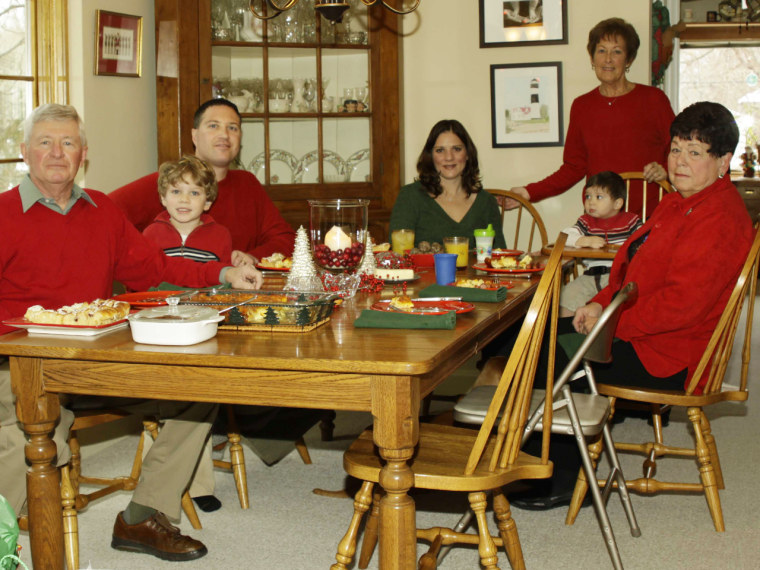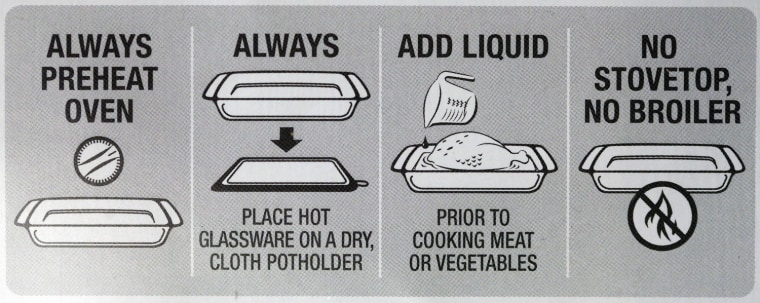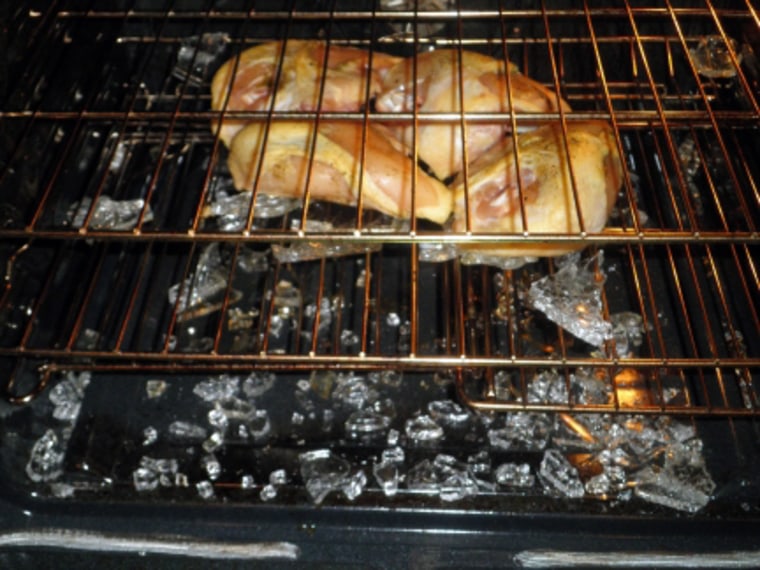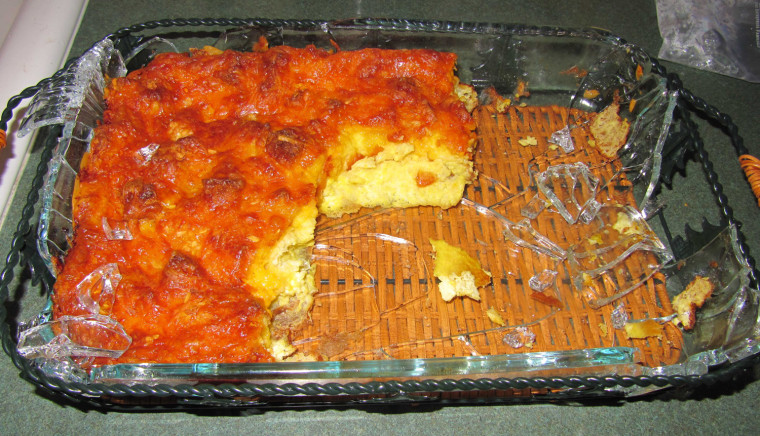Debbie Parker of Pontiac, Mich., says she still can't shake the memory of Christmas morning brunch two years ago when the festive egg casserole she baked in a glass Pyrex pan "exploded" without warning on her holiday table.

“There was this loud crash. We looked to see the dish shattered with shards of glass all around,” recalled Parker, 70, who said she found pieces three feet away under the Christmas tree.
No one was hurt, but Parker said she shudders even now at the thought of her young grandchildren, then ages 1 and 5, who were seated at the table for the family's traditional meal.
“It was right at their eye level or face level,” she said. “We could have spent Christmas Day at the hospital.”
Other consumers say they have been hurt by suddenly shattering glass cookware, including James Sinton, 29, of Houston. Medical records show that he needed stitches in April 2011 to fix a gash on the inside of his right arm after he said a large Pyrex measuring cup broke when he poured boiling water in it to make tea.
“It exploded. There’s no other way to describe it. It instantly became shrapnel,” recalled Sinton, who said he slipped on the wet floor and landed on the glass pieces, cutting himself.
Such incidents are rare, but reports of glassware abruptly shattering have climbed sharply in recent years, NBC News has learned. And a controversy is heating up over whether the pans or the users are to blame.
Complaints about the problem to the federal Consumer Product Safety Commission rose from just two in 1999 to 144 in 2011. That's a total of 576 during those 13 years, records show. This year, 93 incidents had been reported as of mid-November.
Emergency room reports collected in a federal databaseshow that some consumers claim to have suffered cuts to the face when glass pans broke as they opened hot ovens, or claim they’ve been injured by spattering pan juices or hot grease after dishes disintegrated.
At the advocacy agency ConsumerAffairs.com, which posts reviews about popular goods and services, the two top brands of glass cookware in the U.S. -- Pyrex and Anchor Hocking -- have drawn nearly 1,600 reports combined, mostly accounts of unexpected breakage, since the site began in 1998.
“This is without a doubt the highest number of complaints about a single type of cookware or kitchen accessory,” said Jim Hood, founder and editor of the site, which has been reporting on the problem since 2005.
Sheer volume might account for some of the complaints, considering that glass bakeware is found in at least 80 percent of U.S. homes. World Kitchen, the maker of U.S. Pyrex, produces more than 44 million dishes a year, company officials say. Anchor Hocking makes more than 30 million pieces a year.
The rise in reported incidents has raised new questions about the possible causes of unexpected breakage during cooking. A recent article by two scientists at the University of Alabama at Tuscaloosa suggests that today’s pans are more prone to sudden shattering than your grandmother’s hand-me-downs.
But World Kitchen officials have filed a trade disparagement lawsuit disputing that article and claiming that the researchers used faulty science to reach their conclusions. They say that any problems with shattering are rare, and that when they do occur, it may be because consumers don't follow the directions included with all cookware.

Many cooks are surprised to learn that companies, including World Kitchen and Anchor Hocking, have specific safety rules for using glass bakeware.
In instruction leaflets and even embossed on the glass pans themselves, the companies stress correct use.
In responses to complaints filed on the CPSC's SaferProducts.gov site, World Kitchen posts these instructions:
- Always place hot glass bakeware on a dry, cloth potholder or towel. Never place hot glass bakeware on top of the stove, on a metal trivet, on a damp towel, directly on a counter or in a sink.
- Never put glass bakeware directly on a burner or under a broiler.
- Always allow the oven to fully preheat before placing the glass bakeware in the oven.
- Always cover the bottom of the dish with liquid before cooking meat or vegetables.
People who pull their pans out of the oven and set them on a “wet or cool surface” such as a sink or a granite countertop -- found in more and more kitchens these days -- risk sudden temperature changes that could induce shattering, glassware companies say.
The glassware makers also urge consumers to be careful with their pans; impact accounts for far more breakage than heat changes -- and it also can weaken the products, raising the chance of shattering, they say.
World Kitchen officials said in a letter to James Sinton that an examination of his broken measuring cup showed it may have been bruised by “banging” or “dropping.” Sinton, however, said he’d just bought the glassware weeks earlier and didn’t misuse it. World Kitchen didn’t analyze samples of Debbie Parker’s broken dish, and they say they can’t be sure it even was Pyrex, according to press reports after the incident.

At least one cook whose glass pan shattered suddenly last year said she had no idea there were rules about use, especially for such a well-known brand.
“I didn’t follow their directions, but it was Pyrex,” said Laura Lowe, a 47-year-old piano teacher from Evans, Ga.
She said it never would have occurred to her to add liquid to chicken in a baking dish. She assumed that the new glass pans she used were the same material as the pans passed down from her mother and grandmother under a brand once advertised as “icebox-to-oven” bakeware.
Not your grandmother’s Pyrex
There’s no question that the glass pans made in the U.S. today are not your grandmother’s Pyrex.
The original Corning Inc. pans, invented in 1915, were made from a particularly strong material, borosilicate glass. Virtually all glass bakeware sold in the U.S. since the 1980s is now made of a different material, soda lime silicate glass, said Daniel Collins, a Corning spokesman.
Company officials say that soda lime silicate glass is better able to withstand impact if banged or dropped and that it is better for the environment. Ceramics experts also note that it’s cheaper than borosilicate glass.
Recently, Richard Bradt and Richard Martens, the Alabama scientists, set out to explain the increase in reports of shattering. They said they calculated the breaking range for the glass used to make dishes in the U.S. today -- and compared it with that for old-style glass used in original Pyrex.
Then Bradt, a materials engineer, and Martens, an atomic probe microscopist, bought six new glass pans in local stores -- three Pyrex, three Anchor Hocking -- and tested them in Martens’ photoelasticity lab for signs of heat tempering, which boosts the strength of glass.
Their article, published this fall in the American Ceramic Society Bulletin, concluded that the newer glass is far less able to withstand rapid swings in temperature than the older material now used mostly in pans sold in Europe.
“The margin of safety … is borderline,” the scientists wrote.
That conclusion, however, is hotly contested by the glassware makers.
“Anchor’s tempered soda-lime glass bakeware has been in the marketplace for close to 30 years with an excellent safety and consumer satisfaction record,” spokeswoman Barbara Wolf said in a statement.
World Kitchen officials maintain there were errors in the researchers’ work, namely, that they didn’t fully account for the company’s heat-strengthening process.
“The Bulletin feature story contains serious flaws, inaccuracies and highly misleading assertions and assumptions,” said Ed Flowers, the firm’s senior vice president, in a statement to NBC News.
World Kitchen, which acquired U.S. rights to the Pyrex trademark from Corning in 1998, is now suing the American Ceramic Society, the two researchers and a publicist over the trade journal article. The company has demanded a retraction, claiming that the scientists have launched a deliberate “campaign of disparagement” against U.S.-made glass cookware, including Pyrex, according to a complaint filed in federal court.
“Defendants have purposely but needlessly frightened consumers into the false belief that Pyrex glass cookware is unsafe for normal kitchen use and could pose an unreasonable risk of serious injury to those who use it,” the complaint states.
Bradt and Martens are standing by their conclusions. So is the American Ceramic Society, which has refused to retract the paper.
Independent ceramics experts who reviewed Bradt and Martens' paper for NBC News found it to be fundamentally sound, though they said more testing was needed to affirm the conclusions.
Glass bakeware under fire
This is hardly the first time that glass bakeware has come under fire. In 2010, Consumer Reports magazine investigated complaints of shattering cookware by conducting its own tests on borosilicate and soda lime silicate pans. In a dramatic video demonstration, the magazine concluded that the newer pans, including those made by World Kitchen and Anchor Hocking, were more likely to shatter under extreme conditions than the original Pyrex.
Federal safety officials who've looked into the problem say that while there have been injuries, no deaths have been attributed to the unexpected breakage. There are not enough cases to estimate how many people might be hurt in the U.S. each year, said Scott Wolfson, spokesman for the CPSC. Wolfson wouldn’t speculate about what’s behind the growing numbers. He said the agency analyzed the issue in 2008, but found no cause to recall the glassware.
World Kitchen officials described the Consumer Reports piece as “seriously flawed.” As for the ceramics journal report, they say that Bradt had a conflict of interest because he has served as a paid witness in lawsuits against makers of glass cookware.
Bradt acknowledged that he has been hired as an expert witness on behalf of clients who brought lawsuits against U.S. glassware makers about the products in recent years. He would not name any companies involved in those lawsuits, citing confidentiality requirements. The cases were settled out of court, he said.
World Kitchen also stated that reports to the CPSC mentioned in Bradt and Martens’ article have not been documented or authenticated by the agency.
"The number of injuries attributed to glass bakeware breakage (by any maker) is extraordinarily small -- a tiny fraction of one percent,” according to a statement from World Kitchen. “These data also show that in the extremely rare instances when an injury attributed to glass bakeware breakage is reported, it is most often related to impact breakage and not breakage related to severe temperature change."
George Quinn, a retired senior ceramic engineer with the National Institute of Standards and Technology, reviewed the ACS paper for Bradt before it was published. Quinn was among several peers in the ceramics field who reviewed the authors' drafts.
“My own professional opinion is that the thermal strengthening may not be adequate for temperatures in the home kitchen,” he said.
He said he handles glass dishes in his own kitchen “with extreme caution.”
“I’ll set it down on a cloth or on a wooden block,” Quinn said. “I will put a towel over the Pyrex as I am handling it, so if it should break, I will be protected.”

Debbie Parker said she still uses the old Pyrex pans she got decades ago, but won't buy new products.
Parker says she is certain she followed all the rules for proper baking during her holiday brunch. After the new pan broke, she wrote detailed records about the timing, temperature and treatment of her glass Christmas pan.
Still, she says, it shattered. When she complained to World Kitchen about her broken Christmas casserole and the danger it posed to her family, she says the company offered to send a new pan.
“They wanted to replace it. I just laughed,” she said, referring to World Kitchen. “I wouldn’t have another ‘new’ piece of Pyrex in my home.”
Editor’s Note: This story was updated on Jan. 2 to add and clarify comments from World Kitchen.
Related stories: